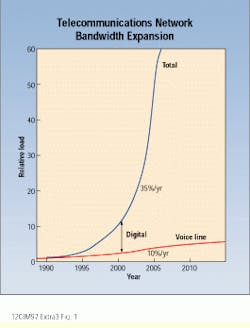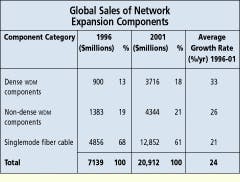Telecommunications growth exceeds expectations
As many telecommunications lines approach capacity, telephone carriers will aggressively expand the digital bandwidth of their networks to stay competitive.
Jeff D. Montgomery, ElectroniCast Corp.
Over the past several decades, North American telecommunications-network capacity (measured in gigabit-kilometers) has expanded almost linearly, at a modest rate of 10% annually for voice lines. Historically, telecommunications-network growth has mainly consisted of the expansion of analog voice circuits because more and more people are talking for a longer time.
Over the past five to six years, however, digital data transport has grown much more rapidly than analog voice transmission. Capacity used for digital transport is now comparable to that of voice-circuit traffic. The crossover point where the bandwidth consumed by digital signals exceeded the bandwidth for analog signals occurred from 1994 to 1995.
Telecommunications networks are therefore expected to be increasingly dominated by digital signals. In fact, the historical linear voice pattern has now been superseded by a new digital transport paradigm, which forecasts that total North American telecommunications bandwidth use will skyrocket, at an average of more than 35% per year from 1996 to 2006.
Underestimated plans
Voice-circuit growth has consisted of more conversations over slowly increasing distance, resulting in a constant data rate. Digital transport, however, brings the added dimension of rapidly rising data rates per subscriber connection. In addition, the number of connections and the increases in average transport distances are projected to expand dramatically, especially during the next decade, over those experienced in voice circuits over the past decade. These characteristics help explain why many network planners, cable producers, and equipment suppliers have greatly underestimated their sales forecasts over the past few years.
One reason is that many telecommunications networks worldwide are near capacity loading. Demand has grown much faster than capacity expansion through the 1990s. Interexchange carriers, in general, have recognized this demand and are responding with commitments to expand their throughput capacity by five to ten times over the next five years. Local exchange carriers, however, faced by market, regulatory, and competitive uncertainties, are moving more cautiously.
The slow expansion of the local exchange carriers is seen by industry analysts as an increasingly critical bottleneck in the global communications network. They claim that the technologies, customer demands, and investment capital are available now. This availability means that the interexchange carriers, global carriers, and new national networks will increasingly bypass the local exchange carriers by using direct subscriber connections. These connections are expected to be implemented, typically, with fiber-optic cables--first to businesses and then to residences. The impressive success of competitive access providers over the past decade is a reliable precursor. Fiber-optic cables are expected to serve as the backbone of the thrust into expanded network capacity.
Carriers choose low cost
Carrier network planners are presently evaluating the various network platform technologies, viabilities, and costs for achieving large bandwidth expansion. The choices, however, are being determined mainly by the first-installed-cost rule, with little weight given to flexibility for long-range expansion or for leading-edge technology. In these cases, the typical planning horizon for local exchange carriers is two years.
Three technologies are being evaluated for the substantial (four times or greater) expansion of bandwidth of an existing network--time-division multiplexing (tdm), wavelength-division multiplexing (wdm), and higher fiber counts. In practice, two or all three technologies are often combined, as follows:
- Install more fiber-optic cables along the route. Add more transmitters and receivers at the same data rates now deployed by filling card slots in existing transport terminals and adding more terminals.
- Replace the existing transmitters (and receivers, if necessary) with higher-data-rate units that use tdm technology.
- Install more transmitters and receivers that operate at the same data rate now deployed. In addition, install more transponder/remodulator units, wdm filter modules, and optical amplifiers to transmit more channels and wavelengths over the existing fiber.
Historically, carriers have initially installed more fibers than immediately required. As bandwidth demand increased, carriers expanded bandwidth by adding more transmitter/receiver pairs, activating more fibers, and replacing the original lower-data-rate transmitter/receivers with higher-data-rate units.
On their busy routes, however, carriers have been forced to activate nearly all of their available fiber. As a result, this situation has left "trading up" to higher-data-rate transmitters as the remaining solution. For example, over the past three to four years, a major deployment of OC-48 (2.5-gigabit-per-second) transmitter/receivers has taken place.
When this path is completed, carriers are expected to continue expansion by deploying even higher-data-rate OC-192 (10-Gbit/sec) transmitter/receivers. These components, however, have proved more difficult to design and produce than expected, delaying their installation. This delay has pushed carrier network planners to consider wdm technology as an alternative.
Component growth
To meet the expected expansion of network capacity, the global sales of network-expansion components are estimated to increase at an average annual rate of 24% and reach $20.9 billion by 2001. The largest component sector--singlemode fiber cable--is forecast to achieve a 61% market share in 2001.
Global sales of fiber-optic-related network-expansion equipment in 1996 are estimated at $4.52 billion. Sales are expected to increase at an average annual rate of 28%, to $15.4 billion in 2001. The largest equipment sector is represented by fiber transport terminals, with a 67% market share in 2001. These terminals include dense wdm Synchronous Optical Network/Synchronous Digital Hierarchy terminals, other sonet/sdh terminals, and non-sonet (asynchronous) terminals.
wdm alternatives
There are three main approaches to deploying wdm technology. The relative cost per bandwidth gained depends on the characteristics of the current network and the amount of bandwidth expansion needed. The relative costs among the alternatives also will change year to year as a function of maturity and volume. These alternatives include the following:
- Install a wdm open system with transponders (remodulators) located at the transmitter end. This system would continue to use the currently deployed transmitters, receivers, and fibers. This approach alone does not increase the number of channels, but it does decrease the number of activated fibers. Network bandwidth can be increased with the existing fibers by installing more transmitter/receiver pairs of the same type currently used and by simultaneously increasing the number of transponder/remodulators and channels accommodated by the wdm filter modules.
- Install new transport terminals with built-in precise-wavelength transmitters, wdm filter modules, and optical amplifiers.
- Retrofit new precise-wavelength transmitters, wdm filter modules, and optical amplifiers into the currently deployed transport terminals; this work can be performed either by the terminal vendor or the carrier.
The leading carriers are now in various stages of cost and performance analyses and field trials of all alternatives for bandwidth expansion. The cost comparisons have been delayed because not all alternatives were commercially available by the end of 1996, but they will by year-end.
Technology adoption
Historically, carriers have been conservative about phasing new technologies into their networks. There can be a lengthy delay from the time an equipment or component supplier announces a new product to the time the product is actually deployed in operational carrier networks. The length of this period depends on the urgency of the problem the new technology might solve, the complexity of the new product, and the extent to which the product differs from current technology.
For dense wdm systems (those complying with the proposed International Telecommunication Union closely spaced wavelength standards) the carriers` procedures for accepting new products include:
- laboratory demonstrations, supported by technical paper presentations,
- product introductions and demonstrations, such as those made at trade shows,
- paper analysis to evaluate product cost and performance attractiveness compared to other products (this approach has been delayed by the unavailability of firm prices for some products),
- laboratory evaluation of products and, typically, other alternatives,
- field trial of the product in an operational network,
- writing procurement specifications, issuing requests for quotes, reviewing, and procuring parts,
- delivery and deployment.
In practice, each of these steps has taken several months. The major interexchange carriers are now at the end of this cycle with wdm products and into the procurement and deployment stage. Most local exchange carriers were between the paper-analysis and field-trial stages at the end of 1996.
Upper limits
An industry "format" of expansion has thus emerged; that is, equipment operational data rates are expanding in multiples of four. For example, the expansion of communications optoelectronics has jumped from OC-3 (155 megabits per second) to OC-12 (622 Mbits/sec) and then to OC-48 and OC-192. The next upward level is expected, then, to be OC-768 (40 Gbits/sec). The OC-192 optoelectronic transmitter, which became commercially available in 1996, defines the practical upper limits of higher tdm data-rate transmission as a bandwidth-expansion tool.
Unlike tdm and wdm technologies, fiber-optic cable deployment is not expected to collide with the upper limits of technical communications performance in the foreseeable future. Fiber counts of one thousand in ribbon cables are now being deployed, especially in Japan, and technology experiments appear promising for higher fiber counts. Furthermore, additional fiber cables can also be deployed along the same route. Fiber deployment is currently limited by the capacity of the small number of available suppliers, but this situation is not likely to last long.
In many network branches, especially in local exchange and cable-TV networks, adding fiber becomes the most economical expansion path. Also, many new networks are expected to be deployed during the next decade, requiring new fiber. And, most of the fiber currently deployed worldwide is technically inadequate to support significant wdm and tdm upgrades. These existing networks must be overbuilt with new fiber as part of the wdm/tdm expansion process.
On the other hand, some limitations of future network bandwidth expansion lie outside the realm of fiber-link technical capabilities, among them:
- Switching capacity--Central-office digital crossconnects must be able to accommodate the expected 14- to 20-fold throughput expansion over the next 10 years. Optical bypass switching can help.
- Right-of-way costs--Right-of-way owners are shifting from a per-distance (kilometer) charge basis to a per-throughput (gigabit-kilometer) basis. This approach is dampening the economic gains of wdm and tdm technologies. q
Jeff D. Montgomery is chairman and founder of ElectroniCast Corp. (San Mateo, CA). This article is excerpted from the May 1997 issue of Lightwave magazine, another PennWell publication.
North American telecommunications network growth has historically consisted of the expansion of analog voice circuits at a moderate pace of 10% per year. This trend has now been superseded by a new market model based on the implementation of digital data transport of telecommunications services. The transmission of digital signals is forecast to boost the growth of telecom-munications network bandwidth by 35% per year from 1996 to 2006.


